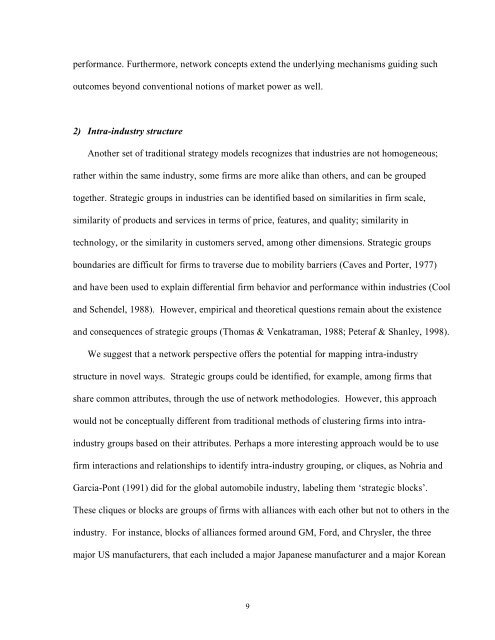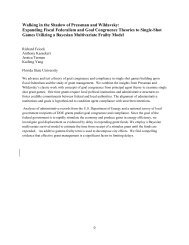STRATEGIC NETWORKS Ranjay Gulati, Nitin Nohria, Akbar Zaheer ...
STRATEGIC NETWORKS Ranjay Gulati, Nitin Nohria, Akbar Zaheer ...
STRATEGIC NETWORKS Ranjay Gulati, Nitin Nohria, Akbar Zaheer ...
Create successful ePaper yourself
Turn your PDF publications into a flip-book with our unique Google optimized e-Paper software.
performance. Furthermore, network concepts extend the underlying mechanisms guiding suchoutcomes beyond conventional notions of market power as well.2) Intra-industry structureAnother set of traditional strategy models recognizes that industries are not homogeneous;rather within the same industry, some firms are more alike than others, and can be groupedtogether. Strategic groups in industries can be identified based on similarities in firm scale,similarity of products and services in terms of price, features, and quality; similarity intechnology, or the similarity in customers served, among other dimensions. Strategic groupsboundaries are difficult for firms to traverse due to mobility barriers (Caves and Porter, 1977)and have been used to explain differential firm behavior and performance within industries (Cooland Schendel, 1988). However, empirical and theoretical questions remain about the existenceand consequences of strategic groups (Thomas & Venkatraman, 1988; Peteraf & Shanley, 1998).We suggest that a network perspective offers the potential for mapping intra-industrystructure in novel ways. Strategic groups could be identified, for example, among firms thatshare common attributes, through the use of network methodologies. However, this approachwould not be conceptually different from traditional methods of clustering firms into intraindustrygroups based on their attributes. Perhaps a more interesting approach would be to usefirm interactions and relationships to identify intra-industry grouping, or cliques, as <strong>Nohria</strong> andGarcia-Pont (1991) did for the global automobile industry, labeling them ‘strategic blocks’.These cliques or blocks are groups of firms with alliances with each other but not to others in theindustry. For instance, blocks of alliances formed around GM, Ford, and Chrysler, the threemajor US manufacturers, that each included a major Japanese manufacturer and a major Korean9




